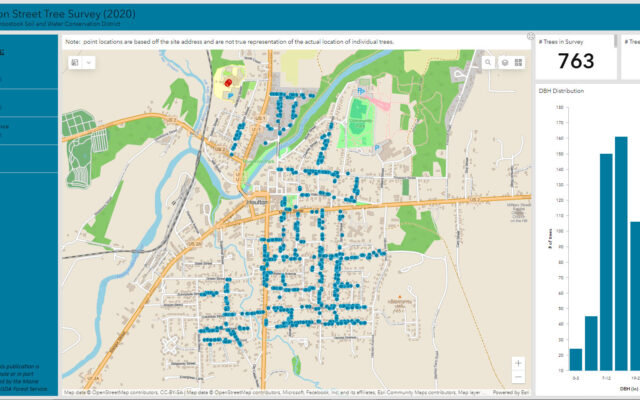
HOULTON, Maine — Houlton will get 15 new trees this spring in an effort to enhance the town’s aging treescape thanks to a Project Canopy Grant.
Many of Houlton’s 763 street trees are more than 120 years old and until now, there has been little attention paid to replacing these ancient trees threatened by age, disease and weather, according to a recently completed Houlton Street Tree Survey.
“There is a noticeable lack of replacement trees,” said Angie Wotton, district manager of the Southern Aroostook Soil and Water Conservation District who applied for an initial Project Canopy Grant to survey the situation.
For example, said Wotton, 26 percent of the sugar maples in town are at least 120 years old, but only three percent of the town’s sugar maples are new.
There are many benefits to having trees in town, she said. They play an important role in water quality by intercepting water and preventing runoff and they play a huge role in mitigating climate change by sequestering carbon, she added.
In 2020, Wotton applied for the first Project Canopy grant through the Maine Forest Service, and with town and volunteer help a survey of 20 Houlton neighborhoods was completed.
Recommendations for the future include developing a tree warden position or for the town to establish a town tree committee. Having someone with the knowledge to help prioritize maintenance and what and where future plantings are needed would be helpful, Wotton shared with the Houlton Town Council on Monday night.
“Tree planning for the future can save the town time and money,” she said.

A Houlton Tree Survey can be detailed street by street in a series of maps created through a Project Canopy Grant of the Maine Forest Service. (Courtesy Southern Aroostook Soil and Water Conservation District)
She also announced a second Project Canopy Grant that will get the town 15 new trees.
“We used an online mapping system to pick three neighborhoods — Highland Avenue, Spring Street and Pine Street — that we’re going to plant trees,” Wotton said. “Letters have been sent to all property owners.”
For the tree survey, a steering committee made up of members from the forest service, town leaders and residents, a plan was developed. And Wotton, along with 24 Houlton volunteers, set out to survey the street trees in 20 sections of town, she said.
Surveyors were trained in how to assess tree health, age and how to use certain tools, she said.
A mock survey was first used as practice, Wotton said.
Then the volunteers began collecting data that included street address, land use, tree species, crown and trunk health, trunk diameter, utility line interference and surveyor comments.
It took most of the summer to survey the assigned sections. Over the winter, the data collected for the town’s 763 street trees was entered into a software program. An ArcGIS interactive map in partnership with Maine USDA Natural Resources Conservation Services GIS Specialist Tara King was created, Wotton said.
The interactive map illustrates the 20 sections surveyed, and interested residents can go to the online map to search information about the age of trees by species and the streets they are on.
A quick search shows that on High and Park streets, there are seven trees more than 120 years old, and there are 80 trees in that range throughout the town.
Additional map searches found that there are 36 sugar maples, 57 American elms, 55 Norway maples, 223 trees with utility wire interference and 24 new or young trees in town.
Wotton pointed out that there were 40 documented species in Houlton, but three species — sugar maple, Norway maple and paper birch — dominated.
Maine has prohibited the sale of the Norway maples since 2018 because it is invasive, she said.
“I never thought personally of a Norway maple as a problem as a street tree, but after conducting a survey on a couple of areas myself, I changed my mind,” she said, adding that she could see the seedlings popping up in the middle of other plantings such as lilac bushes.
She also said she was surprised at the limited number of red oaks at only 4.6 percent.
“It is a species that will be a go-to in reestablishing tree lined streets,” Wotton said.
Councilor Sue Tortello, who was a volunteer surveyor, said that trees are wildly popular in Houlton.
“When I was participating in the survey you wouldn’t believe how many people came off their porches, came over and wanted to know what I was doing and they got all excited because of that,” she said.
Wotton added that the survey was a great opportunity to educate homeowners.
“I’m just asking you, we get in our car, we drive the same route to work, we don’t see our surroundings,” she said. “But the next time you drive or go to work just take a minute and shift your focus and look. I think you will see what the surveyors saw.”







